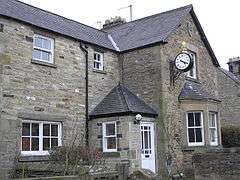Aldbrough St John
Aldbrough St John is a village and civil parish (called Aldbrough) in the Richmondshire district in North Yorkshire, England. The parish has a population of 325 (2001 census), increasing to 392 at the 2011 Census.[1]
| Aldbrough St John | |
|---|---|
 Estate house at Aldbrough St John - formerly a post office hence the clock | |
 Aldbrough St John Location within North Yorkshire | |
| Population | 392 (2011 census)[1] |
| OS grid reference | NZ202112 |
| Civil parish |
|
| District | |
| Shire county | |
| Region | |
| Country | England |
| Sovereign state | United Kingdom |
| Post town | RICHMOND |
| Postcode district | DL11 |
| Police | North Yorkshire |
| Fire | North Yorkshire |
| Ambulance | Yorkshire |
History
In Norse language Aldbrough means "Old Burh" or fortified stronghold.[2] The St John suffix was added to the name in the 1930s by the Post Office to avoid confusion with the Aldborough near to Boroughbridge.[3]
At one time, Aldbrough St John had a "small castle". We know this from John Leland's account in 1540 that "There appere great ruines of a howse or litle castel at Albruch village, and thereby rennith a bekke. It standith a 2 mile south from Perse Bridg on Tese". Perse Bridg is now called Piercebridge 2 miles north of Aldbrough referred to above as Albruch.[4]
The village is 6 miles (9 km) west of Darlington, 7 miles (12 km) north of Richmond and 2 miles (3 km) north of junction 56 on the A1(M) motorway.[5] The road north from junction 56 of the A1(M) is part of Dere Street and runs up to Piercebridge and beyond. Because of its proximity to the Roman Road in the east, the A66 (former Roman Road) to the south and the River Tees to the north, suggestions of Romano-British settlements persist around the village.[6]
When the Duchess of Northumberland came to live in the village in the 1865, she had many of the old properties removed and the stone used to build new houses.[7] It is generally accepted that any castle remains were also removed at this time. The foundations of this building were recently found by local historians Ian Wardle, Grant Rowley and David Shires in what is believed to have been the "burh" oval. A property of this type within the village is thought by Ian Wardle to be the reason why Aldbrough not only kept, but increased in value in Norman times when all villages around were sacked and burned. He believes that Aldbrough was at the centre of the lands occupied by the local lord so may have been spared. This information is further expanded on the village website.
Quarries at the south-western edge of the village supplied a red limestone that was used for buildings in Richmond, Aldbrough St John, Forcett, Stanwick St John and East Layton. The church in Aldbrough St John is constructed of this stone.[8]
A packhorse bridge crosses Aldbrough Beck near Aldborough which is grade II listed.[9]
References
- UK Census (2011). "Local Area Report – Aldbrough St John Built-up area (1119883376)". Nomis. Office for National Statistics. Retrieved 5 November 2018.
- Ekwall, Eilert (1960). The concise Oxford dictionary of English place-names (4 ed.). Oxford: Clarendon Press. p. 5. ISBN 0-19-869103-3.
- ASJCAA 2004, p. 4.
- Leland, John (1909). Smith, Lucy Toulmin (ed.). The Itinerary of John Leland in or about the years 1535–1543: Parts VII and VIII. 4. London: George Bell and Sons. p. 27. Retrieved 8 December 2016.
- "304" (Map). Darlington & Richmond. 1:25,000. Explorer. Ordnance Survey. 2015. ISBN 9780319245569.
- Lang, James (2001). "II: Historical background to the sculpture". Corpus of Anglo-Saxon stone sculpture. Oxford: Oxford University Press. p. 6. ISBN 0-19-726256-2.
- Lloyd, Chris (8 August 2015). "From The Archive: Stanwick, Aldbrough, Eppleby and Caldwell". The Northern Echo. Retrieved 13 November 2017.
- Everett, Shirley (May 2012). "A Building Stone Atlas of North Yorkshire, West" (PDF). British Geological Survey. p. 19. Retrieved 13 November 2017.
- Historic England. "Packhorse Bridge over Aldbrough Beck (Grade II) (1316888)". National Heritage List for England. Retrieved 13 November 2017.
Sources
- Aldbrough St John Conservation Area Study (PDF) (Report). Richmond: Richmondshire District Council. 2004. Archived from the original (PDF) on 14 November 2017. Retrieved 13 November 2017.
External links
| Wikimedia Commons has media related to Aldbrough St John. |
- Aldbrough in the Domesday Book
- Aldbrough St John website (Archive Copy)